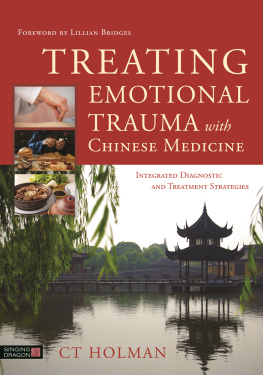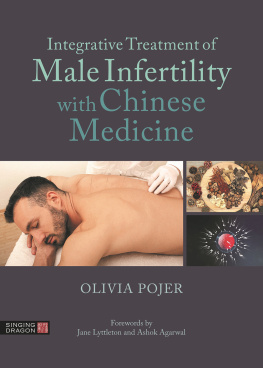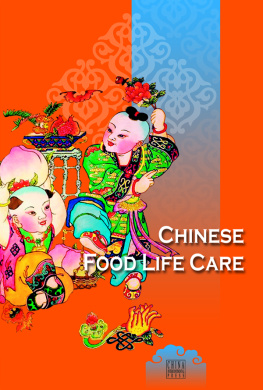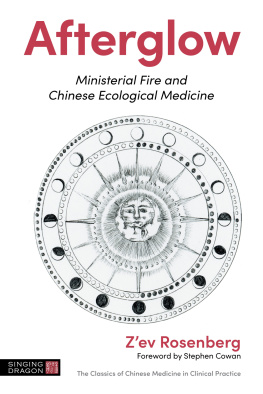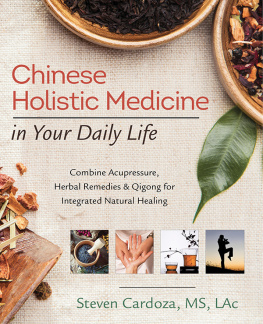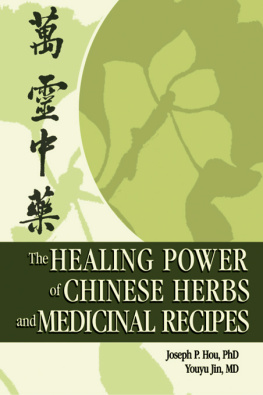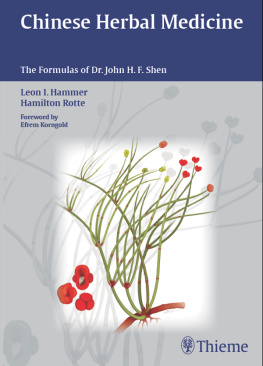Yang - Chinese Herbal Formulas - Treatment Principles and Composition Strategies
Here you can read online Yang - Chinese Herbal Formulas - Treatment Principles and Composition Strategies full text of the book (entire story) in english for free. Download pdf and epub, get meaning, cover and reviews about this ebook. year: 2010, publisher: Democrite - Giga, genre: Children. Description of the work, (preface) as well as reviews are available. Best literature library LitArk.com created for fans of good reading and offers a wide selection of genres:
Romance novel
Science fiction
Adventure
Detective
Science
History
Home and family
Prose
Art
Politics
Computer
Non-fiction
Religion
Business
Children
Humor
Choose a favorite category and find really read worthwhile books. Enjoy immersion in the world of imagination, feel the emotions of the characters or learn something new for yourself, make an fascinating discovery.
Chinese Herbal Formulas - Treatment Principles and Composition Strategies: summary, description and annotation
We offer to read an annotation, description, summary or preface (depends on what the author of the book "Chinese Herbal Formulas - Treatment Principles and Composition Strategies" wrote himself). If you haven't found the necessary information about the book — write in the comments, we will try to find it.
Yang: author's other books
Who wrote Chinese Herbal Formulas - Treatment Principles and Composition Strategies? Find out the surname, the name of the author of the book and a list of all author's works by series.
Chinese Herbal Formulas - Treatment Principles and Composition Strategies — read online for free the complete book (whole text) full work
Below is the text of the book, divided by pages. System saving the place of the last page read, allows you to conveniently read the book "Chinese Herbal Formulas - Treatment Principles and Composition Strategies" online for free, without having to search again every time where you left off. Put a bookmark, and you can go to the page where you finished reading at any time.
Font size:
Interval:
Bookmark:
To my parents, Sujing Jia and Youming Yang, for their love and dedication; for giving me the chance to live, to feel, to think, to learn; for everything
In memory of my beloved friend Dr Paul J. Loncq de Jong, who devoted his life, soul and body to medical work and research.

2010, Elsevier Limited. All rights reserved.
No part of this publication may be reproduced or transmitted in any form or by any means, electronic or mechanical, including photocopying, recording, or any information storage and retrieval system, without permission in writing from the publisher. Permissions may be sought directly from Elsevier's Rights Department: phone: (+1) 215 239 3804 (US) or (+44) 1865 843830 (UK); fax: (+44) 1865 853333; e-mail: .
First published 2010
ISBN: 978 07020 3132 8
British Library Cataloguing in Publication Data
A catalogue record for this book is available from the British Library
Library of Congress Cataloging in Publication Data
A catalog record for this book is available from the Library of Congress
Notice
Neither the Publisher nor the Author assumes any responsibility for any loss or injury and/or damage to persons or property arising out of or related to any use of the material contained in this book. It is the responsibility of the treating practitioner, relying on independent expertise and knowledge of the patient, to determine the best treatment and method of application for the patient.
The Publisher


Printed in China
For Elsevier
Commissioning Editor: Mary Law
Development Editor: Ewan Halley
Project Manager: Joannah Duncan
Designer: Kirsteen Wright
Illustration Manager: Gillian RichardsIllustrator: Jonathan Haste
It was with great pleasure that I read the first book of Yifan Yang in 2002. This was Chinese Herbal Medicines: Comparisons and Characteristics. What was so refreshing about Comparisons and Characteristics was the clear and detailed description of the functions of the different temperature and taste properties, so that the reader understood why different herbs have different actions. The author then developed this into the excellent contrasts of similar herbs based on differences in temperature, taste, and action. This is vital to the clinical practice of herbal medicine. If the practitioner does not understand the detailed differences between herbs, then they cannot make effective herb combinations.
Chinese Herbal Formulas: Treatment Principles and Composition Strategies carries on this good work and greatly enlarges upon it. To make safe and effective herb combinations, the practitioner must understand the structure of herbal formulas and the principles underlying their construction.
We can say that herb combinations are made up of working units: single herbs, herb pairs and herb trios. For each of the main syndrome groups, whether Exterior Wind syndromes or Deficiency syndromes, Yifan Yang discusses the main herb pairs, herb trios, and single herbs that are the foundation for herb formulas to treat that syndrome. Then she organizes these working units into the categories of Chief, Deputy, Assistant, and Envoy, according to their importance and their role in the combination. This is followed by clear analysis of famous formulas on that syndrome.
It is hard to overemphasize the clinical importance of understanding how to use pairs and trios as the foundation of herb formulas. It gives great flexibility and precision to the practitioner. Without this understanding, practitioners can only use set formulas or their very simple modifications. With this understanding the practitioner can make combinations to meet the changing needs of individual patients that are specific, sophisticated, effective and safe.
The author has also given most useful practical details, such as adjusting dosage according to patient's constitution and diet, or according to season and climate. She has emphasized contra-indications, both for Chinese herbal medicine in general and for each Chinese syndrome group in particular. It is obvious that Yifan Yang is a thoughtful, careful, and successful practitioner who has made a life's work of communicating her clinical skills and theoretical knowledge for the benefit of others. I, for one, am very grateful.
Jeremy Ross, UK
Chinese herbal formulas, which have been shown to be effective for a wide range of applications, form one of the main therapeutic modalities of traditional Chinese medicine. As clinical experience has accumulated over the generations, so the number of formulas has increased steadily over time. The formula classic Sheng Ji Zong Lu (Comprehensive Recording of Sage-like Benefit) ( ad 11111117), for example, contains approximately 20 000 formulas covering disorders in multiple disciplines. For centuries, practitioners have tried to find ways to summarize these formulas in order to better apply them in clinical practice as well as to study their underlying strategies to assist the creation of new formulas.
Traditionally, the primary method of learning to become a practitioner of Chinese herbal medicine has been through focusing on a large number of classical formulas. Students memorize the compositions and indications of these formulas, remember the associated treatment strategies and use them as examples to create their own formulas for clinical use.
This method of learning has obvious strong points. As each formula is designed to treat a specific condition, it is in fact a detailed, vivid individual case study of a specific treatment. Unfortunately, this method also has some weaknesses. First, the basic rules which govern the principles and strategies of formula composition are not introduced directly, nor are they arranged in any systematic order. As a result, students often have to spend additional time mastering the skill of formula composition in the course of years spent learning hundreds of classical formulas. Second, because these principles and strategies are not emphasized as essential knowledge in the study of herbal formulas, but merely passed on as background information, some practitioners are much more interested in seeking effective pre-existing formulas to treat ailments instead of creating their own formulas according to the precise syndrome differentiation. These efforts subsequently often yield less than satisfactory therapeutic results. Furthermore, as the number of new formulas increases over time, students and practitioners are easily overwhelmed by the amount of new information instead of following essential principles and focusing on learning to create their own formulas.
As a teacher and practitioner of Chinese herbal medicine, I have searched for a new way of studying, teaching and practicing. In this book, I have aimed to summarize from a large number of formulas the basic rules which inform treatment principles and composition strategies. I hope by training practitioners to follow these principles and use these strategies that they will be able to select appropriate herbs independently and to compose individualized formulas to treat various syndromes.
In this book, 19 of the most commonly seen syndromes, along with more than 60 sub-syndromes, are discussed. They are carefully analyzed and divided into principal syndrome and secondary syndrome, represented by main symptoms and secondary symptoms respectively, with specific signs of the tongue and the pulse. Associated disorders, as identified by modern medicine, are also mentioned. After the syndromes are clearly identified, the treatment principle and plan are explained, together with cautions. Following that, the principles of herb selection used to compose the formulas and the various treatment strategies are introduced, along with carefully selected herbs which are recommended to perform the functions of chief, deputy, assistant or envoy. This will allow practitioners to feel comfortable in selecting the most appropriate chief and deputy herbs from a number of recommended herbs to treat the main and secondary symptoms in the syndrome, as well as selecting the assistant and envoy to make the formula more balanced and effective. Each of the recommended herbs is explained with details on its specific function in treating one possible disorder in the syndrome. Through the incorporation of selected herbs, each carries out a specific role in the overall strategy. Finally, some outstanding classical formulas are included in each chapter to serve as examples. They are analyzed with particular regard being given to the strategies used in their composition in order to help inspire practitioners to create new formulas.
Font size:
Interval:
Bookmark:
Similar books «Chinese Herbal Formulas - Treatment Principles and Composition Strategies»
Look at similar books to Chinese Herbal Formulas - Treatment Principles and Composition Strategies. We have selected literature similar in name and meaning in the hope of providing readers with more options to find new, interesting, not yet read works.
Discussion, reviews of the book Chinese Herbal Formulas - Treatment Principles and Composition Strategies and just readers' own opinions. Leave your comments, write what you think about the work, its meaning or the main characters. Specify what exactly you liked and what you didn't like, and why you think so.

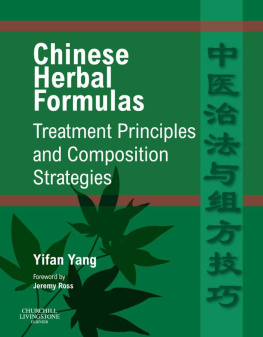

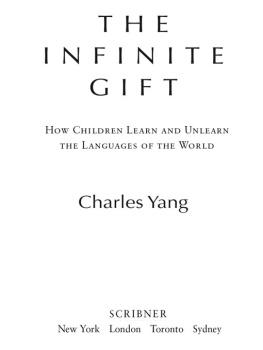
![Yang - The latehomecomer: [a Hmong family memoir]](/uploads/posts/book/165016/thumbs/yang-the-latehomecomer-a-hmong-family-memoir.jpg)


